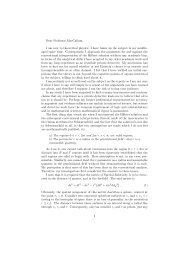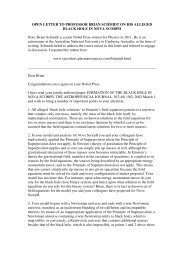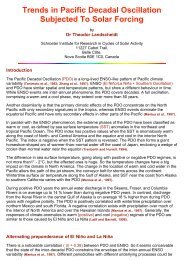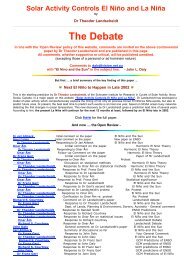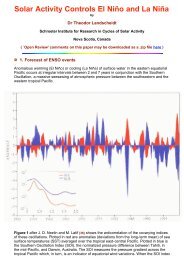Sun-Earth-Man - PlasmaResources
Sun-Earth-Man - PlasmaResources
Sun-Earth-Man - PlasmaResources
Create successful ePaper yourself
Turn your PDF publications into a flip-book with our unique Google optimized e-Paper software.
7 2 SUN-EARTH-MAN: AMESH OFCOSMIC OSCILLATIONS<br />
XIII. PYTHAGOREAN HARMONY<br />
One of the first interdisciplinary approaches to a holistic understanding of our<br />
world was that of Pythagoras and his disciples. They created the theory of the<br />
functional significance of numbers in the objective world and in music. Their<br />
famed dictum "all is number" meant that all existing entities can be ultimately<br />
reduced to number relationships that do not only link mathematics to music<br />
theory, but also to acoustics, geometry, and astronomy. Even the dependence<br />
of the dynamics of world structure on the interaction of pairs of opposites, the<br />
first of which is the even-odd polarity essential to numbers, emerges from<br />
these number relationship^.'^^ Pythagoras would have been happy to learn of<br />
attractors opposite in character that are created by simple feed back cydes of<br />
numbers and form tenuous boundaries, dynamic sites of instability and<br />
creativity.<br />
Pythagorean thinking deeply influenced the development of classical Greek<br />
philosophy and medieval European thought, especially the astrological belief<br />
that the number harmony of the universe affects everything including<br />
terrestrial affairs in their relation to space-time configurations of cosmic bodies.<br />
Men were intrigued by the precision of those number relationships between<br />
musical harmonies, that deeply touch man's soul, and prosaic arithmetical<br />
ratios of integers. This connection was first demonstrated by Pythagoras<br />
himself in the sixth century B.C. In his famous experiment a stretched string<br />
on a monochord was divided by simple arithmetica1 ratios as 1/2, 213, 3/4,4/5,<br />
516 and plucked. It was a Eureka moment when he discovered that the<br />
respective partitions of the string create the consonant intervals in harmony.<br />
One tone is not yet music. One might say it is only a promise of music. The<br />
promise is fulfilled, and music comes into being, onIy when tone follows upon<br />
tone. Strictly speaking, therefore, the basic elements of music are not the<br />
individual tones, but the individual tone to tone moves. Each of these moves<br />
spans a certain pitch distance. The pitch distance between two tones is called<br />
an interval. If the basic elements of a melody are the individual moves, melody<br />
is a succession of intervals rather than of tones.Im Intervals can be consonant<br />
or dissonant. It was Pythagoras' great discove& to see that the ratios of the<br />
first small integers up lo six give birth to consonant intervals; the smaller these<br />
integers, the more &rnplete the resonance. A string divided in the ratio 1 : 2<br />
yields the octave (C-C') of its fundamental note, an equisonance. The ratio 2<br />
: 3 - the entire length of the string to two thirds of its length - yields the fifth<br />
(C-G), 3 : 4 the fourth (C-F), 4 : 5 the major third (C-E), 5 : 6 the minor thir4<br />
(E-G), and 3 : 5 the major sixth (C-A). The pairs of notes given in brackets are<br />
-<br />
examples of the respective consonances.<br />
The minor sixth created by the ratio 5 : 8 seems to go beyond the limit six.<br />
But eight,>he only integer greater than 6, is only the third power of 2 which<br />
is a member of the senarius of consonant numbers; eight is created by an octave<br />
operation which gives birth to absolutely equisonant tones. All authorities<br />
agree that besides the equisonant octave thereare no other consonant intervals<br />
than the third, the fourth, the fifth and the sixth.'" If more than two notes are<br />
to be consonant, each pair of them must also be consonant. As mentioned<br />
already, the most complete consonance within the range of an octave is the<br />
XIII. PYTHAGOREAN HARMONY 7 Q<br />
major perfect chord C-E-G = 4:5:6 that unites the major third and the fifth to<br />
the fundamental note. These concepts of harmony, harmonic intervals and<br />
chords are not an arbitrary invention. The consonant intervals are formed in<br />
nature by the first terms in the series of overtones or harmonics. The harmonic<br />
series was unknown m the age of Pythagoras. It was discovered by Marin<br />
Merseme in 1636, and the inherent law of nature was found by Joseph<br />
Sauveur in 1702. When there is a musical sound, there is always In addition a<br />
series of harmonics that relate the fundamental tone to an infinity of overtones<br />
which influence the quality of the fundamental. The overtones up to the slxth<br />
harmonic represent the consonant ~ntervals: the octave, the fifth, the fourth,<br />
the major third, the mlnor third, and the sixth.



